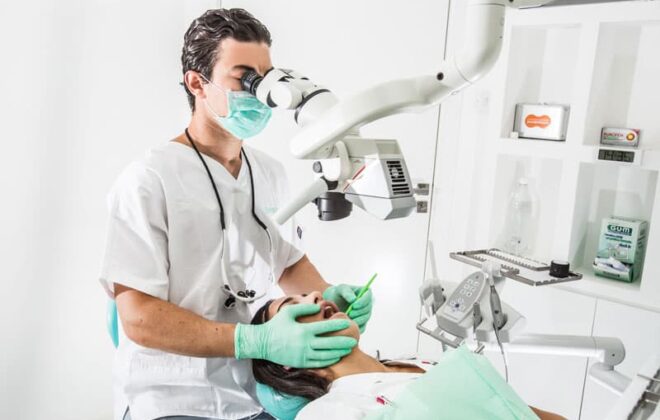Innovations in Root Canal Treatment in the Modern Era
In this new era of technological advancements, root canal treatments are getting easier to perform every day to provide the patients a seamless experience.
High-tech instruments are now used in root canal treatments that make the procedure easier for both patients and dentists. By the virtue of the technological advancement in modern root canal treatment, teeth can now be treated without any invasive surgery. With the latest instruments and state-of-the-art technologies, dentists now have the resources to complete successful root canals in just one painless visit of the patients.
On a positive note, the success rate for such treatments is very high, and besides, wet-fingered dentists are always breaking a sweat to improve their treatment methods both technically and diagnostically. These methods are beneficial in scenarios where dentists try to better visualize the treatment sites radiographically and intraorally.
Today, our dentists can locate calcified canals better than before, and they are not just trying to improve their quality of service, but also striving to perform faster. This is particularly important when dealing with endodontic emergencies and anxious patients. In this article, we will discuss some of these new-age instruments and techniques used to treat patients more efficiently by Yorkhill Endodontics. Finally, some good news for the sweet tooth people!
Enhanced diagnosis of the treatment site
Being able to make a proper diagnosis has always been a fundamental and common issue in endodontics. Start with asking yourself the following question. Do you have any idea about the problem when a tooth with a history of root canal treatment is indicative, but the periapical radiograph is showing no significant complication? This used to be a regular issue when evaluating the molar teeth radiographically as they are covered by the cheekbone and sinus. This was just one example of the many other limitations that dentists have faced over the decades with traditional equipment. Anyway, in modern days, with the development of the 3-D cone beam computed tomography (CBCT) imaging, and enhanced magnification, all these issues are in the past now.
Cherry Creek endodontists in Denver use advanced technology like CBCT to diagnose root canals. Their team can produce 3-D pictures with Dental Cone Beam CT technology, in addition to the two-dimensional pictures of the teeth by using digital and low-radiation x-rays. How does this make a difference? The commonly used x-rays are used to provide 2-D views of the teeth and bones, whereas, CBCT produces 3-D tomography with the incredibly detailed structure of the teeth and facial skeleton. The CBCT rotates around the patient’s head, clicking hundreds of images that are automatically compiled into 3-D radiographic images. The scanning times usually take less than a minute, and the radiation level is the same as the traditional dental x-rays.
This information is then saved automatically in the machine’s storage and is available for viewing at once. The endodontists can slice the 3-D picture in multiple ways, allowing them to visualize each root canal within a tooth. You might not know that teeth have between one and three roots and within these roots, several canals can be as thin as a hair strand. CBCT’s high-resolution digital imaging allows viewing the exact shape and branches of each root canal and helps to locate the infected area very precisely.
Root canal instrumentation
Canal instrumentation is another area of endodontic treatment that has seen significant progress over the years and all credit goes to advances in file designs and metallurgy for making these instruments even faster and precise than before. A very widespread issue with the traditional instrumentation was the root canal transportation of calcified and curved canals. This is a critical issue when using larger stainless hand files but with the advent of newer NiTi files, it’s now proven that canal curvatures can be better followed with this instrument than with hand files.
Modern magnification technology in treating root canals
The development of high-powered surgical microscopes and loupes is another huge milestone that has been introduced to root canal therapy. Cherry Creek endodontists of Denver use this technology and can look through loupes, a high-tech binocular attached to glasses, or through a specially designed microscope that is positioned over the patient’s mouth to see the tiniest root canals within each tooth. This development has significant importance because many of these canals are so small that they can’t be seen with bare eyes. Our endodontists use modern hand files which can be as thin as a string to clean the damaged area and replace the pulp with a special, biocompatible material to preserve the natural tooth.
Laser root canal treatment
Laser root canal therapy is the most recent innovation in root canal therapy by using which the endodontists in Denver precisely clean the root’s canal without using any drills or hand files. The technology uses a laser and high-pressure water system to wash away the infection, reduce post-operative pain, healing time, and possible side effects.
Looking after the comfort of our patients
People once used to fear even the word root canal because of the pain. Anesthetics in Denver found a way to make it easier to numb the tooth, so the patient doesn’t feel any pain during the procedure. Their team also has nitrous oxide available, which is also known as the laughing gas. The gas is passed through a mask which the patient breathes remaining awake and comfortable during the procedure. The effect of the gas wears off within a few minutes after the mask is removed. The Denver endodontists turn a patient’s tears and fear into a laughter session, and what can be better than getting a good laugh?
Furthermore, other sedation options are also available for patients with severe dental anxiety. Some patients prefer to be put to sleep during the procedure and if that’s the case, these endodontists can arrange an anesthesiologist to come to Denver for administering the general anesthesia during the therapy. Modern science and technologies are making a big difference for people to receive the dental care they always feared to take.
Takeaway
The greatest innovations that have occurred in clinical endodontics can be directly related to the phenomenal progress in technology. Such procedural breakthroughs will continue to bring new advancements in the future. Nevertheless, many of these inventions and innovations have outstanding potentials to make endodontics easier, faster, and better in all ways. With these geniuses and professionals from Denver, the field of endodontics is moving closer to fulfilling its promise to the general public. The experienced endodontics of Denver are working day and night to make sure their patients receive painless and successful treatments with just one visit.
Article originally appeared at: https://www.healthtechzone.com/
Author: HealthTechZone



